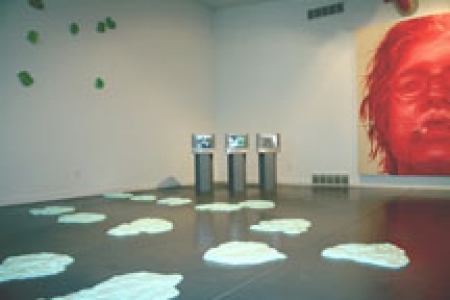Past Exhibition
BIG
Steven Laurie
Anna Barelkowska
Kathleen Ritter
Liz Phillips
Demian Petryshyn
Brendan Fernandes
January 2006
The exhibition Big, curated by Patrick Mahon, features the works of six recent MFA graduates from The University of Western Ontario in London.
What is big? In this exhibition, it is a noun, an adjective and an adverb. It is an elastic term which stretches in order to contain complexity; modifies in order to make succinct; and acts as a reminder to viewers that, first and foremost, the works of artists such as those represented here draw attention to the nuances which inflect what is large and not so large to inform our lives.
In the work of Steven Laurie, bigness seems to most readily refer to the sounds made by the artist s hyper-masculinized, machine-based sculptures. Laurie s work cannily posits big noises as powerful and capable of taking up a great deal of psychological space while also marking a distance between the producer and receiver that acts as a measure of mutual vulnerability. The works of Anna Barelkowska make viewers feel big as they hover over a collection of cool, island-like forms which are strewn in an elegant, random formation on the floor of the gallery.
Some of the works in the exhibition invoke scale, whether large or small, in a way that is intended to function metaphorically. In the work of Kathleen Ritter the bigness of the artist s video projection of sites within the city of London makes viewers feel as if we are there -- and therefore are more implicated in the subtly imagined performances Ritter proposes for the locations. Liz Phillips, whose paintings refer to the giant portraits made by New York artist Chuck Close in the 1960's and after, includes a small self-portrait which, through reference to her own earlier pieces, appears as if it could be big -- but somehow does so using highly economic means.
Demian Petryshyn’s video work reflexively depicts the artist himself and his younger brother playing video games, and comments incisively on the way in which various forms of popular culture make those whom society deems to be big become, perhaps temporarily, undifferentiated from those who are supposedly not big. Brendan Fernandes, whose work makes reference to the overdetermining touristic impulses which influence our conceptions of places of the other, such as various countries in Africa, reminds us of what it means to conceive of that continent as big. In Fernandes work, the common notion of the bigness of Africa points to the reductiveness of thinking about culture which tries to homogenize complex collections into simplistic entities.
(Excerpt from exhibition brochure essay by Patrick Mahon)

